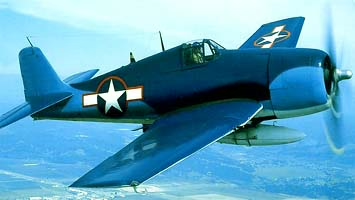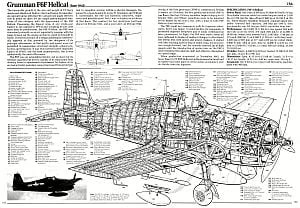Grumman F6F Hellcat History
The Grumman F6F Hellcat, essentially a larger and more powerful development of the Grumman F4F Wildcat, flew in its original XF6F-1 form on 26 June 1942, with a 1,700 hp Wright R-2600-10 Cyclone engine. It was then re-engined with a 2,000 hp Pratt & Whitney R-2800-10 Double Wasp to become the XF6F-3, flying in this form on 30 July 1942. Production F6F-3s were virtually unchanged from this aircraft; they began to appear early in October 1942, making their operational debuts with the British Fleet Air Arm in July 1943 and with the US Navy a month later. Production for the US Navy totalled four thousand six hundred and forty-six F6F-3s, including eighteen F6F-3E and two hundred and five F6F-3N night fighters; a further two hundred and fifty-two were supplied to the British Fleet Air Arm as the Hellcat I.
Aerodynamic and control-surface improvements were introduced on the F6F-5, which entered production in 1944 and was able to operate in the fighter-bomber role with under-wing weapons. The F6F-5 was powered by an R-2800-10W engine capable of 2,200 hp using water-injection, and was both the principal and the last production Grumman F6F Hellcat model. By November 1945, when production ended, twelve thousand two hundred and seventy-two Hellcats had been manufactured. Of these, six thousand four hundred and thirty-six were of the F6F-5 model, nearly one-fifth of which were F6F-5N night fighters; and nine hundred and thirty others were essential similar Hellcat IIs for the Royal Navy. Whereas its predecessor, the Wildcat, had been used in both Atlantic and Pacific war areas, the Grumman F6F Hellcat operated predominantly in the Pacific.
With the speed and rate of climb which had obviously been lacking in the F4F, and with a full range of flight characteristics completely void of any unusual tendencies, the Hellcat was superbly suited to its role as a carrier-based fighter.
Data compiled by the Office of Naval Intelligence and released in May 1948 credit the Grumman F6F Hellcat with 5,155 Japanese aircraft shot down – well over half of the 9,258 shot down by all types of U.S. Navy aircraft. The Hellcat’s closest competitor, the F4U Corsair, is credited with 2,140 kills during World War Two.
After the war, the Grumman F6F Hellcat quickly faded into obscurity. Although a few special purpose versions, such as the F6F-5N, remained in first-line service as late as mid-1950, the majority of Hellcats were relegated to training role. In the Flight Training Command, the F6F served as an advance trainer until 1950, when it was replaced by the Grumman F8F Bearcat. In the Naval Reserve, the F6F equipped many “Weekend Warrior” squadrons, and was still in use by a few squadrons as late as 1953.
Grumman F6F Hellcat Specifications
| Aircraft Type: |
| fighter |
| Dimensions: |
| wingspan: 42 ft, 10 in |
| length: 33 ft, 7 in |
| height: 13 ft, 1 in |
| Weights: |
| empty: 9,042 lb |
| gross: 12,186 lb |
| Power plant: |
| 1 × 2,000 hp Pratt & Whitney Double Wasp R-2800 radial engine |
| Performance: |
| maximum speed: 376 mph |
| ceiling: 37,500 ft |
| maximum range: 1,090 mi |
| Armament: |
| 6 × 0.50 in calibre machine guns |
| 2,000 lb of bombs |
| Operational Use: |
| 1943–1950 |











this was a very helpfull site, it has blueprints and specifications of the F6F Hellcat